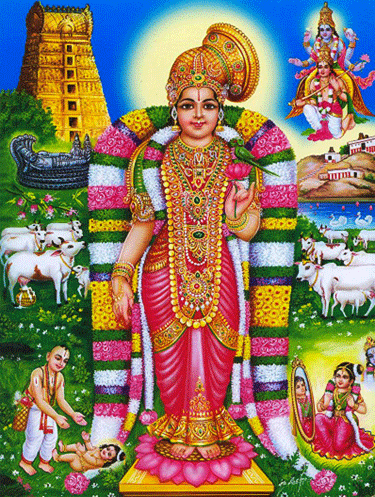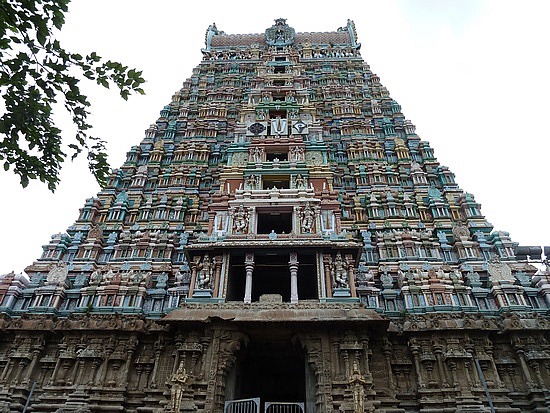Published from “Three Minutes” series written by A.S.Rajagopalan Swami of Ohio.
 tol pAvai pADi aruLa valla pal
tol pAvai pADi aruLa valla pal
vaLaiyAi
(taniyan for ANDAL by uyyakkoNDAr)
pal = (Oh!) many
vaLaiyAi = bangles worn (ANDAL),
tol = (those) ancient
pAvai = hymns
pADi = (You can) compose /sing
valla = (and has the) ability
aruLa = (to) bless (us)
Today, we will look at the life of ANDAL, the only female among the AzhvAr-s (saints who were immersed in depths of of enjoyment of the Lord shrIman nArAyaNa). AzhvAr-s visualized the Lord and their experiences broke out and overflew as sweet tamizh verses (nAlAyira divya prabandham), which are the essence of holy scriptures (veda-s). Yet, ANDAL has a unique place among the AzhvAr-s in instructing the intricacies of upaniShad-s in a nutshell and so svAmi deshikan called her two compositions tiruppAvai and nAcciyAr tirumozhi as “ANDAL’s upaniShad-s”. Hymns written in praise of ANDAL (vAzhit tirunAmam) also call the mystical lyrics of tiruppAvai as the seed for all the scriptures (vedam anaittukkum vittAgum) and pronounces further that those who are ignorant of these thirty verses are wasting their life on this earth (aRiyAda mAniDarai vaiyyam sumappadum vambu).
ANDAL, who is the descent (avatAra) of earth goddess (bhUdevi), the divine consort of Lord shrIman nArAyaNa, appeared as a small baby lying on the ground of viShNucittar’s (periyAzhvAr) flower garden. Her original name was gOdA, the daughter of the earth. You can see even from the name gO[vin]da, she has captured the Lord Himself and tied Him up within herself.
The main purpose of Her appearance on earth was bi-fold: (1) Wake up the individual souls and teach them the means for liberation from bondage of birth/death cycles (2) Wake the Lord up and instruct Him to forgive our mistakes and accept our surrender and service. This intrinsic mediating adventure, she carried out through explicit verses on Her love, reveals her strong yearning and extreme devotion towards Lord KR^iShNa.
The word tiru means shrI. The word pAvai has several meanings – a girl; a picture; the pupil of the eye; a doll or statue when it is a shortened version of padumai; a garland etc. Even days long before ANDAL, it was customary in tamizhnADu for young unmarried girls (kanyA peN) to perform the vow or ritual (pAvai nonbu). It involves making up the dolls out of sand on the shores of the river and pray to God to be blessed with a good husband or for the rain and general prosperity of the town. Here also, ANDAL’s vow (pAvai nOnbu) has two main themes: prosperity of the devotional wealth (bhakti selvam) and the inner craving of the individual souls (cetana) to reach the Lord to redeem themselves via their eternal relation to Him. Scriptures call Lord as the only male (puruSha) and all rest of the souls as females.
The life of ANDAL is remarkable with a romantic simplicity. She may be just five years old at that time and was in deep love with Lord KR^iShNa. Her passion intensified to the level that she couldn’t distinguish the imagination from reality. In her mind, she went back on a time machine to the days of KR^iShNa, completely out of sync with the reality of time, space or state. She pretended to be one of the cowherds living with Lord KR^iShNa in AyarpADi and poured out the verses filled with bridal mysticism.
She chose the month of mArgazhi (dhanur), which is the last month before the post vernal equinox period (uttarAyaNam) begins. Why this month? It is considered each day of angel calendar is equivalent to one year in human calendar. So this month represents the hours just before dawn which is auspicious (brahma muhUrtam). Lord KR^iShNa also refers that He represents this month amongst all months (mAsAnAm mArgaShIrSho aham). This early morning period is filled with calmness and spiritual feeling and is the best to meditate on Lord.
ANDAL’s tiruppAvai expresses the main theme of waking up Her friends, proceeding to the river bed with singing prayers, and eventually bathing the deity and themselves. Filled with beautiful dialogues, these apparently playful verses subtly incorporate the highest philosophical concepts. ANDAL worships Lord KR^iShNa, yearns to serve Him eternally, and seeks to achieve permanent happiness.
Bhagavad rAmAnuja declared that tiruppAvai, as a verification of shrivaiShNava philosophy. Bhagavad rAmAnuja spreads the greatness of this by reciting (anusandhAnam) this stotram daily and insisting that everyone else should do so. Hence, he was aptly named tiruppAvai jIyar (saint). The history of ANDAL and her eminence was an example for many. svAmi deshika’s composition of godAstuti, in saMskR^it, could have been instrumental to spread her fame in north. Amukta mAlyada, a telugu composition by King KR^iShNa devarAyalu includes ANDAL and tiruppAvai; even in Southeast Asia, places like Indonesia has rituals reflecting ANDAL’s tiruppAvai and this vow.
ANDAL’s life and legend and the essence of tiruppAvai can be summarized in two phrases – Her unswerving relationship to the Lord (uRROmE yAvOm), and ceaseless service only to Him (unakkE nAm AT seyvOm). In fact, just like Lord KR^iShNa used arjuna to reveal the bhagavad gItA, here ANDAL used Herself as an excuse (vyAjam) to reveal the supreme philosophical concepts.
What we learn from here –
1. Devotion with emotion. Any form of devotion (bhakti) like singing, meditating, making garlands, dressing up the Lord’s archa-vigraha, cooking food to offer for Him etc. Indulge yourself in spirit.
2. Playmate is the soul mate. Here ANDAL’s assumed playmate, Lord KR^iShNa, is the savior for everyone.
3. Can’t win if you are not in. Lord loves service to Him and His devotees (bhagavad, bhAgavada kaiMkaryam). Participation on these is essential for the realization of the soul’s final objective of eternal service.
We loved with a love that was more than love









